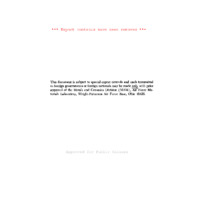-
Title
-
Development of Improved Methods of Depositing Iridium Coatings on Graphite.
-
Date
-
1968
-
Index Abstract
-
Not Available
-
Photo Quality
-
Complete
-
Report Number
-
AFML TR 67-195 Part 2
-
Creator
-
Macklin, Buford A.
-
LaMar, Paul A.
-
Corporate Author
-
General Technologies Corp Springfield VA
-
Laboratory
-
Air Force Materials Laboratory
-
Extent
-
82
-
Identifier
-
AD0843766
-
Access Rights
-
Export Control
-
Distribution Classification
-
1
-
Contract
-
AF 33(615)-3617
-
DoD Project
-
7350
-
DoD Task
-
735002
-
DTIC Record Exists
-
No
-
Distribution Change Authority Correspondence
-
AFML USAF LTR
-
Abstract
-
Oxidation protection of graphite by the formation of a pore- and crack-free iridium coating has been accomplished. A multiplicity of chemical vapor deposition, fused-salt, and aquesous electrodeposition methods were evaluated for the preparation of iridium coatings. While it was possible to deposit coatings 1 to 3 mils in thickness in one processing step, such thick deposits tended to develop trees and nodules. Thick coating (3 to 8 mils) were deposited on samples provided to AFML in multiple depositions of 0.5 mils each. The entrapment of solutions from aqeuous electrodeposition caused cracking in the graphite and precluded its use for depositing iridium coatings. Efforts to form an iridium-rhenium alloy by fused-salt electrolysis and aqueous electrodeposition from electrolytes containing both elements were not successful. Only iridium was obtained from fused salts and the deposits from the aqeuous electrolytes were not homogeneous. Likewise, effortd to increase the emittance of iridium by inclusion of either ThO2 or HfO2 in iridium from fused salts were not successful. A method of nondestructive testing of the oxidation resistance of the iridium by a gas-chromatographic method showed promise as an evaluation technique.
-
Report Availability
-
Full text available
-
Date Issued
-
1968-09
-
Provenance
-
Lockheed Martin Missiles & Fire Control
-
Type
-
report
-
Format
-
1 online resource
 AFMLTR67-195part02.pdf
AFMLTR67-195part02.pdf